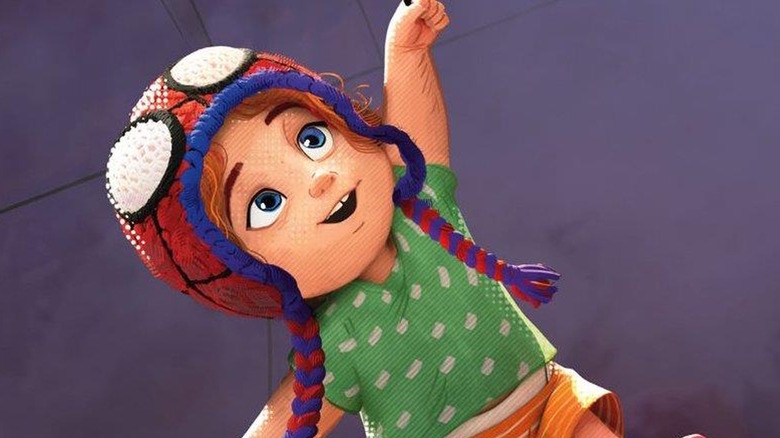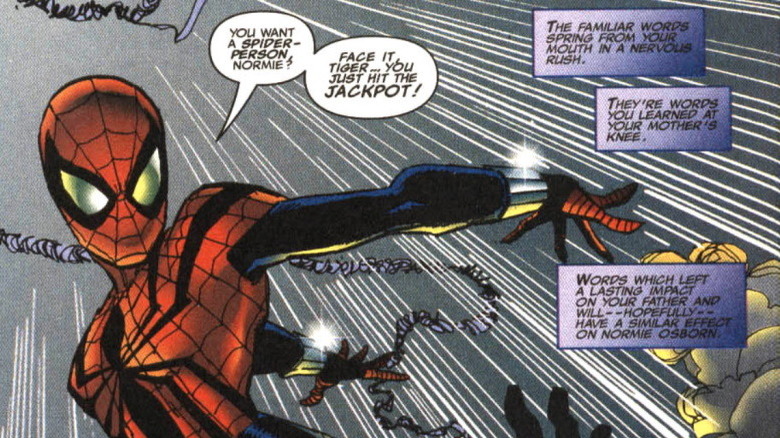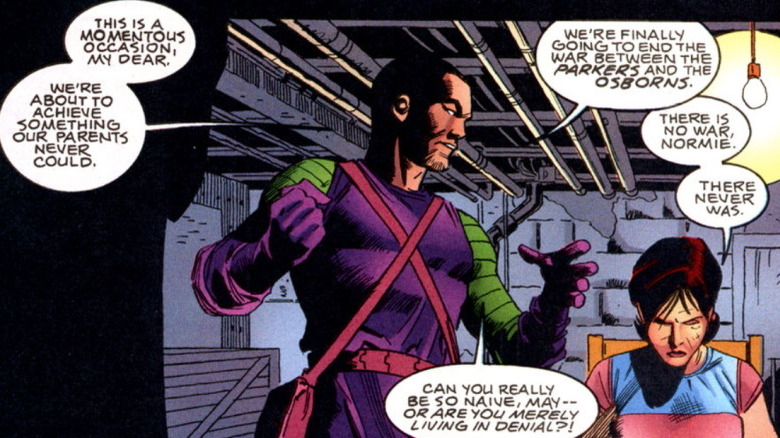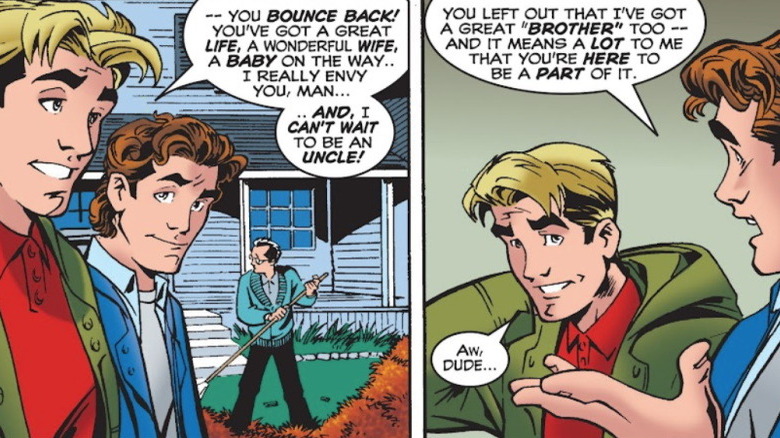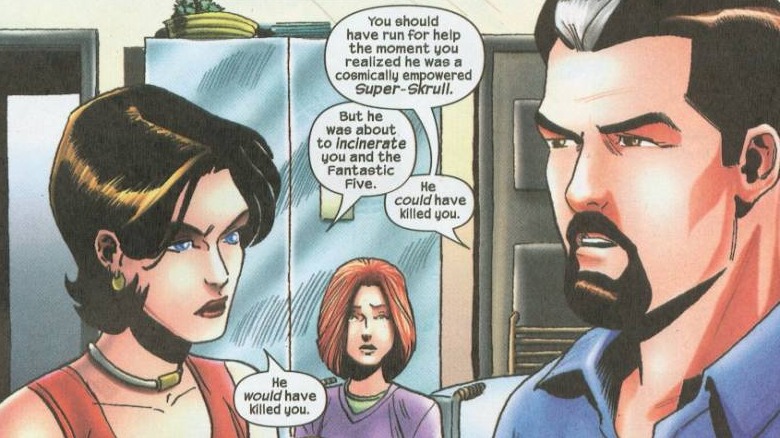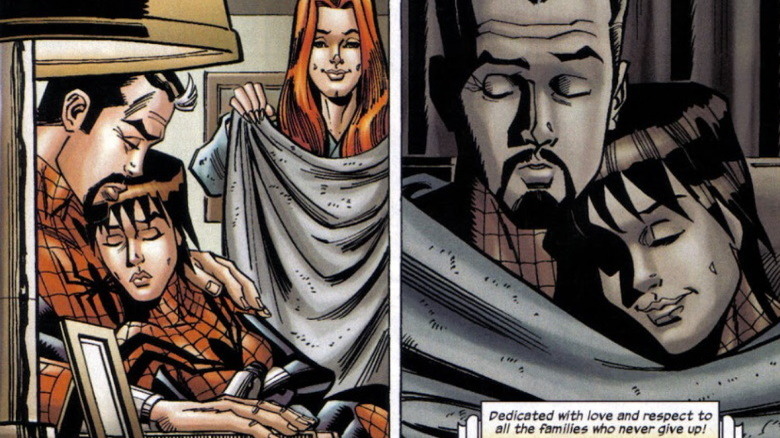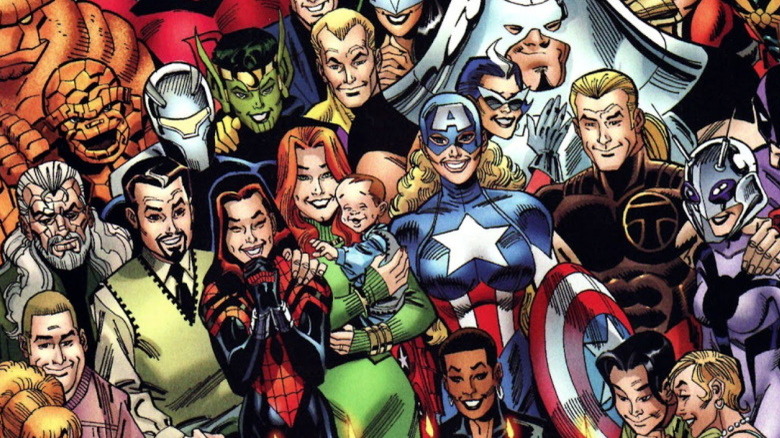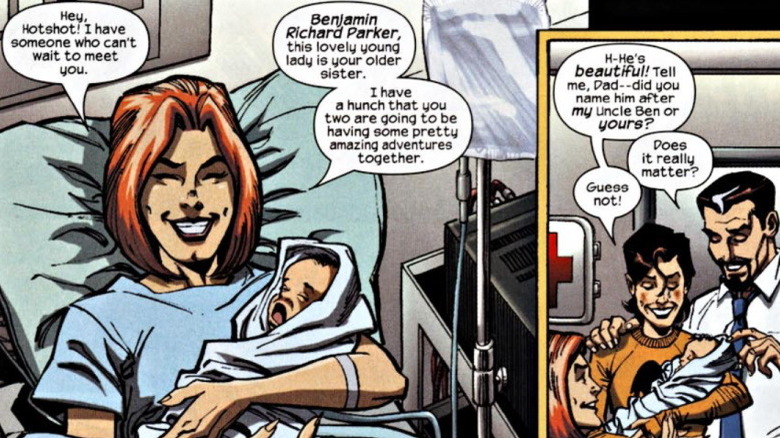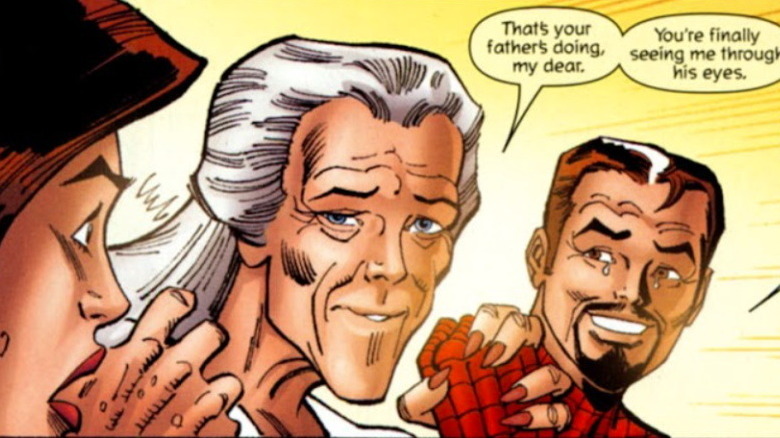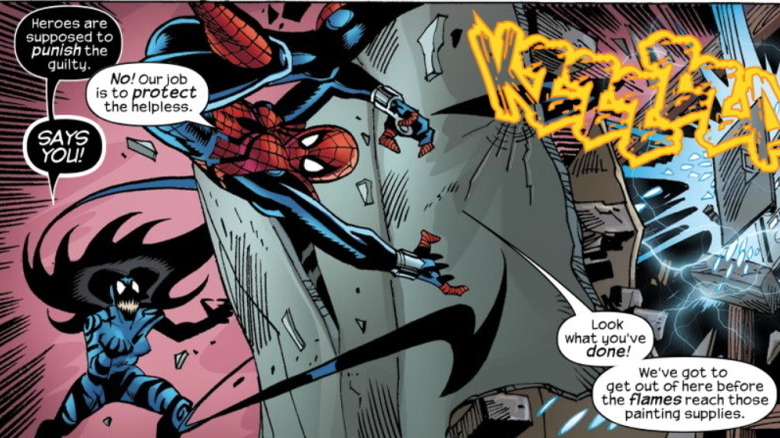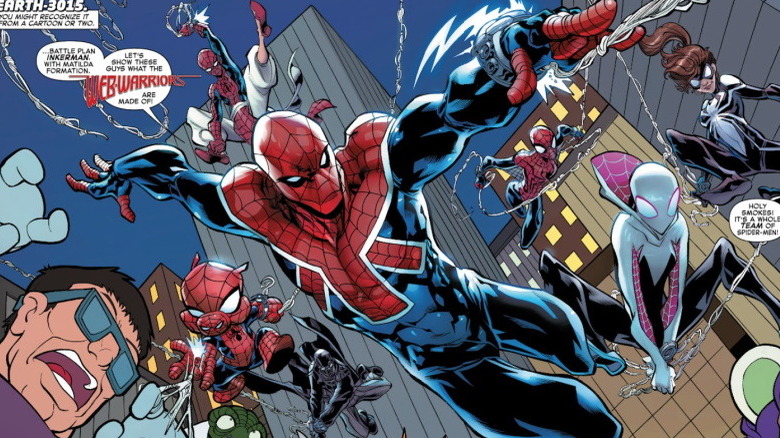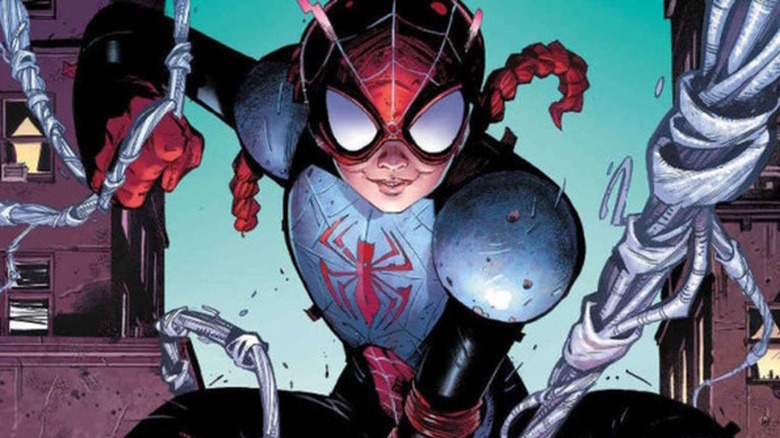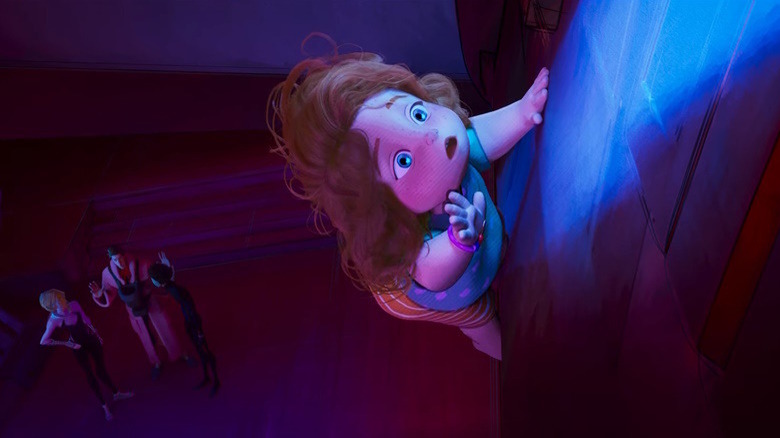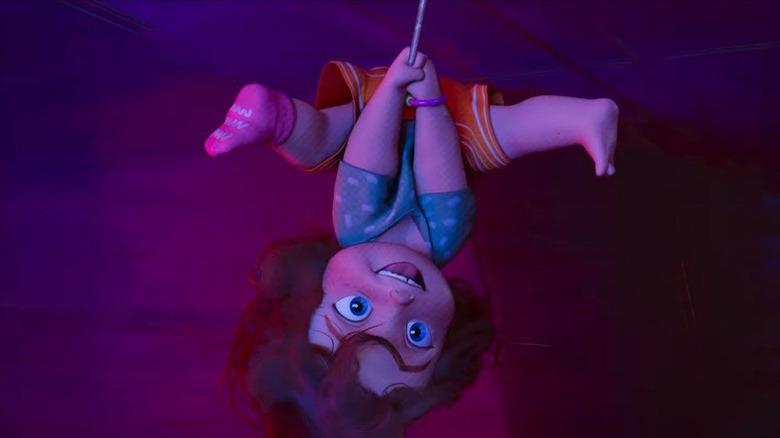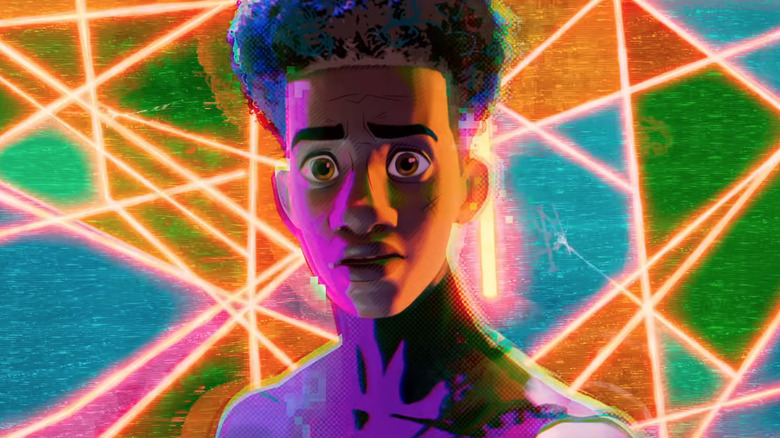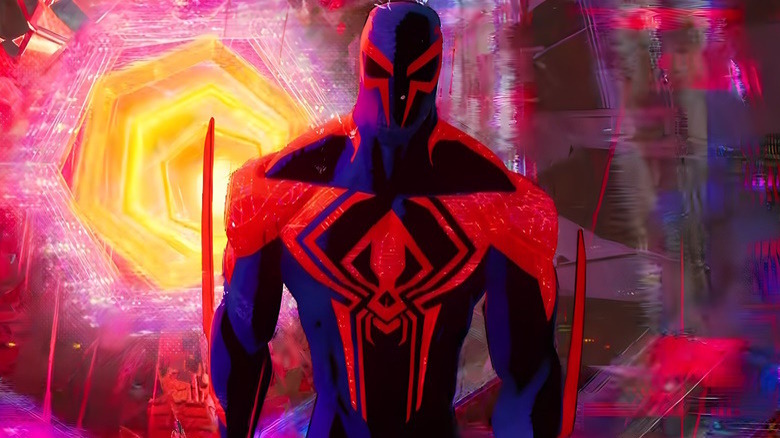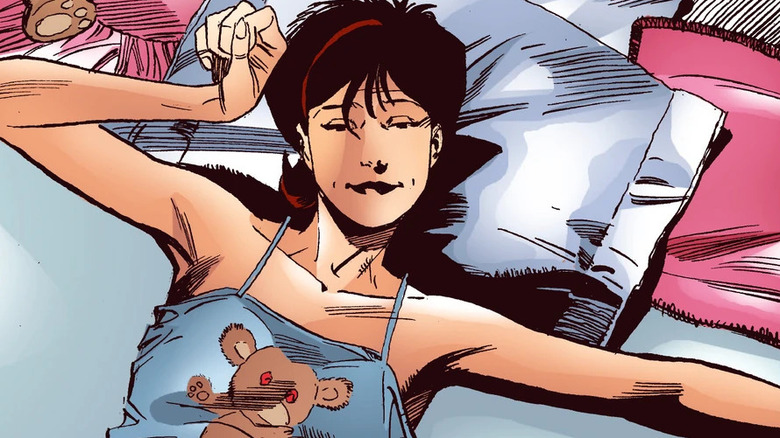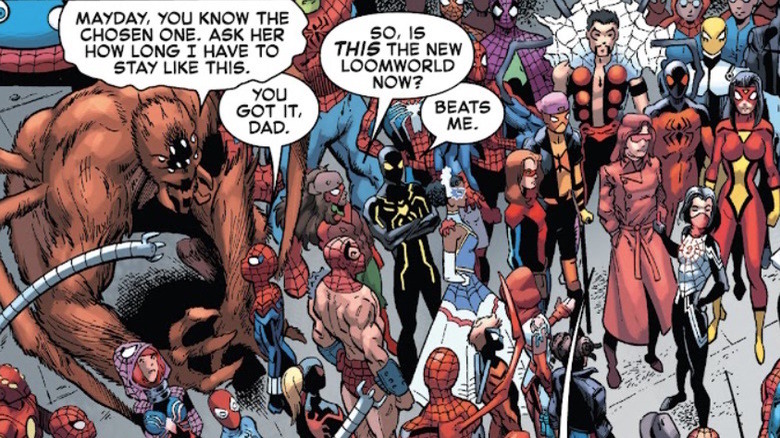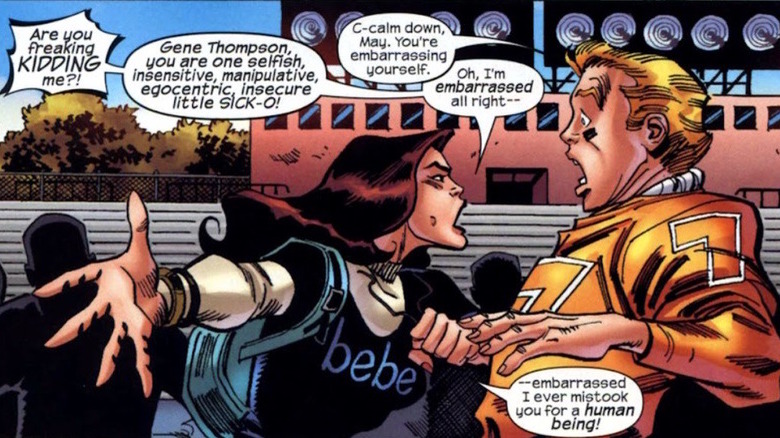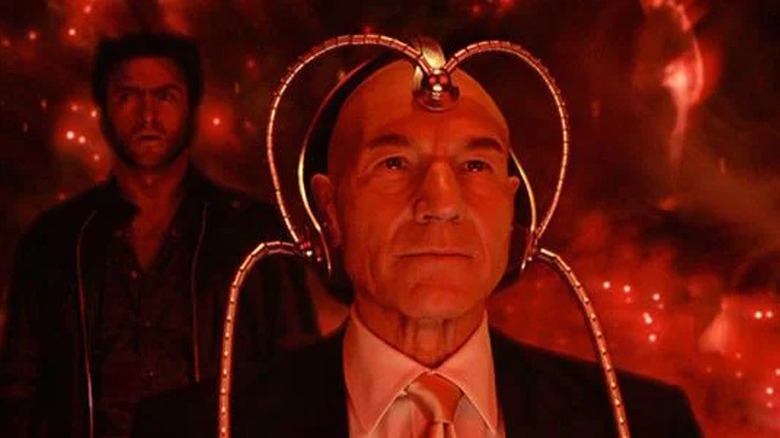Mayday Parker: Facts Only Marvel Comics Fans Know About Spider-Girl Herself
2023's "Spider-Man: Across the Spider-Verse" is packed with variants of Spider-Man, but one of the characters the film introduces us to is someone Marvel Comics fans have been wanting to see on the big screen for decades — May "Mayday" Parker. Although Mayday appears as a baby in the film, comic book fans know that a teenage Mayday Parker already has a rich heroic legacy in the comics, one many people hope to see played out in the movies.
It doesn't end there though. Turns out Peter Parker has several other daughters in the multiverse, and many of them have helped inspire the movie version of Mayday. By learning more about these fan-favorite characters and the impact Mayday's already made on Marvel Comics, we can better anticipate how baby Mayday might affect the "Spider-Verse" movie franchise moving forward. With that in mind, here are some of the greatest facts only Marvel Comics fans know about Mayday Parker — the Amazing Spider-Girl.
She's the daughter of two Spider-Man staples
May "Mayday" Parker is the daughter of Peter Parker and Mary Jane Watson. In the mainstream Marvel Universe, MJ became pregnant with Peter's child during the "Clone Saga" storyline and the Parkers were ecstatic about becoming parents, even naming their daughter after Peter's Aunt May.
But shortly after May was born, Alison Mongrain, an agent of Norman Osborn aka The Green Goblin, stole the baby; MJ was told her child was stillborn. In the later "One More Day/Brand New Day" story arc, the demon Mephisto seemingly erased May from ever being born, concerned that she could end his reign on Earth.
However, in the alternate future "MC2" timeline (designated Earth-982), Peter's clone Kaine rescued May and returned her to the Parkers. In "What If –?" #105, readers learned that May grew up ignorant of her father's superhero career after Peter lost his leg in a final battle with the Green Goblin and retired as Spider-Man. She became a very popular student who loved playing basketball and went by the nickname "Mayday." Upon turning 15, however, May's spider powers emerged, and she began to get curious about her family history.
She owes her superhero career to the Green Goblin
As May learned about her father's heroic legacy, Normie Osborn, the grandson of the Green Goblin, was carrying on his own twisted legacy. Believing Peter Parker was responsible for his grandfather's death, Normie became a new version of the Green Goblin and began harassing Mayday and her friends, telling her that he had "unfinished business" with her father.
The Goblin's attacks showed May she could use her new strength, speed, and senses to protect her friends and she began to pressure her parents into telling her what was going on. Eventually, Mary Jane gave in and told her daughter about the long-running feud between the Parkers and the Osborns. Meanwhile, Peter confronted Normie, telling him that Spider-Man no longer existed. Realizing her father was in no shape to take on the Green Goblin alone, May decided to take matters into her own hands and became Spider-Girl. Despite her lack of experience, she proved more than a match for the Goblin, and Normie was committed to an insane asylum.
In "Spider-Girl" #27, Normie escaped and captured May, hoping she would kill him and end the Parker-Osborn war. Instead, May helped Normie recover his sanity, ending their family feud in a different way. Later, in "Spider-Girl" #29, after discovering May temporarily lost her powers, Normie decided to help her stay in action by outfitting her with his old Goblin gear. May even began developing romantic feelings for Normie; he let her down easy, saying he would always look out for her.
She has her own Uncle Ben
While Mary Jane was pregnant with May, Peter turned over the responsibility of being Spider-Man to his clone Ben Reilly, who created a brand-new costume and gadgets for his time as the wall crawler. Although Ben loved being Spider-Man, he sacrificed his life to save Peter from the Green Goblin in "Spider-Man" #75, asking Peter to please tell May about "her Uncle Ben" as he died.
Peter made sure May knew that Ben Reilly was a hero who died before she was born, and May decided to wear Ben's version of the spider-suit when she became Spider-Girl. She later started using the gadgets Ben invented, including "stingers" that could knock out an opponent and "impact webbing" that would expand on contact. Peter even mentioned that May reminded him of Ben, as they both genuinely enjoyed being heroes.
Unfortunately, in the mainstream Marvel Universe, Ben Reilly's heroic legacy was tarnished when he was resurrected as a villain — first as the evil mastermind The Jackal in the "Clone Conspiracy" storyline and later as the criminally insane Chasm. While he's made multiple attempts to become a hero again, events regularly conspire to place him on a dark path.
She's based on Marvel Editor-in-Chief Tom DeFalco's niece
Behind the scenes, Mayday has a unique origin — she's based on her co-creator's real-life niece. Former Marvel Editor-in-Chief and "Spider-Girl" writer Tom DeFalco created Mayday Parker after hearing how his brother, a Vietnam vet, was horrified that his 16-year-old daughter wanted to be a cop.
"He'd say, 'She's only a kid, how can she think about risking her life?'" DeFalco recalls. "And I said, 'But John, when you were eighteen, you were in Vietnam!' And he said, 'That's different, I knew what I was doing. She doesn't know what she's doing.'"
Intrigued by their arguments, DeFalco decided to use the conflict to shape the dynamic between Peter and Mayday, characterizing Peter as a doting father who doesn't want his daughter to follow in his footsteps. This caused May to engage in superheroics behind Peter's back in early issues of "Spider-Girl," although Peter eventually came around and began training his daughter to be a superhero.
"A lot of readers thought, 'Peter Parker was a superhero! He should be thrilled his daughter is a superhero!'" DeFalco said in 2015. "Except — Peter knows the dangers of being a crime fighter. In his eyes, his little girl will always be his baby. And you don't want your baby to be at risk. I think those are important and natural feelings."
Her comic book history mirrors Spider-Man's success
Spider-Man fans know that Spidey's origin appeared as a one-shot story in "Amazing Fantasy" #15 after Stan Lee couldn't get his editor interested in the character. But did you know that Spider-Girl has a similar comic book history? After the mainstream version of Mayday Parker was written out of the comics by having her stolen (and possibly killed) by the Green Goblin, writer Tom DeFalco and artist Ron Frenz decided to share their vision of what a teenage May Parker would be like in their one-shot story "Legacy... In Black and White" in "What If –?" #105. The story proved so popular that Marvel decided to create a spin-off series, "Spider-Girl," which continued May's adventures.
Originally, the series was intended to only last 12 issues — but fan interest allowed it to keep going. Later, when low sales again threatened the book with cancellation, a vocal fanbase convinced Marvel to give "Spider-Girl" several stays of execution, eventually allowing the book to last for 100 issues.
But this wasn't the end of Spider-Girl, as Mayday's story continued in "The Amazing Spider-Girl" and then several backup features in "The Amazing Spider-Man Family." DeFalco also wrote several prequel stories under the title "Mr. and Mrs. Spider-Man" that also appeared in "The Amazing Spider-Man Family." This was followed by the short-lived title "The Spectacular Spider-Girl" and finally "Spider-Girl: The End." May continues to guest star in other Spider-Man stories, showing once again that some heroes never fade away.
Her world is full of second-generation Marvel heroes ... and villains
Fans who love seeing the Marvel Universe constantly expand and grow in the MCU will appreciate that Spider-Girl's MC2 universe is filled with next-generation heroes and villains ready to honor — or tarnish — their parents' reputation.
Shortly after "Spider-Girl" debuted, Marvel came out with "J2," a comic that follows the exploits of Zane Yama, the half-Japanese son of the X-Men villain the Juggernaut. More civic-minded than his old man, Zane learned he could transform into a Juggernaut-like being Shazam-style and used his powers to help people. He later joined the Avengers in the comic book "A-Next," teaming up with Scott Lang's daughter Cassie — now the shrinking hero Stinger — as well as American Dream, a descendant of Captain America's girlfriend Peggy Carter, and even the son of the Black Panther. Spider-Girl herself has worked with the Avengers and occasionally teams up with Wild Thing, the daughter of Wolverine and Elektra.
Unfortunately, not every hero's child turns out so well. In a creepy twist, the MC2 version of Hank Pym's daughter Hope is the villainous Red Queen. Along with her twin brother Henry Pym Jr. (who went by "Big Man"), Hope tried to destroy the Avengers in "A-Next" #12. Thankfully, her brother stopped her and later began working on a team with other reformed villains.
She's not the only person to carry on the Parker legacy
Mayday may have had a hard time convincing her dad to let her follow in his web steps, but readers would later learn that there were other heroes in the MC2 carrying on the Parker legacy. In "Spider-Girl" #2, May encounters the Darkdevil, a demonic version of the blind hero Daredevil. Later, in the "Darkdevil" miniseries, it is revealed that Darkdevil is the son of Spider-Man's clone Ben Reilly, making him May's cousin. After being possessed by both the spirit of Daredevil and Zarathos, the demon that helped create Ghost Rider, "Reilly Tyne" decides to carry on the heroic legacy of both Spider-Man and Daredevil as his own dark hero.
Later, Peter and Mary Jane have another child, Mayday's little brother Benjamin Parker. While Benjy starts out as a normal baby, he's briefly possessed by the Carnage symbiote in "The Amazing Spider-Girl" #11 which awakens his dormant spider powers. He even shows everyone he can create his own webbing in "The Amazing Spider-Girl" #30, indicating that the MC2 will have another Spider-Man in its future.
She has teamed up with Aunt May
Although May was named after Peter's Aunt May, she never got to meet her namesake; May passed away before she was born — and stayed dead in the MC2 Universe, although her mainstream counterpart was eventually resurrected. Thanks to the magic of time travel, Mayday finally came face-to-face with Aunt May in "Spider-Girl" #10 when an accident sends her back in time to the days when Peter Parker was just a teenager. May ends up visiting Aunt May briefly as "May Day," and her great-aunt is so happy Peter has friends like the "charming and intelligent" young lady who shares her name
Later, Mayday learns May Parker has always been watching over her, as she begins having visions of a serene blonde woman who guides her on a spiritual journey and helps her combat the spirit of Norman Osborn. In "The Amazing Spider-Girl" #30, the woman reveals she's the ghost of Aunt May, who is proud of her entire nephew's family.
Later still, May gets to work with a different version of Aunt May when she meets May Reilly, a young inventor from an alternate steampunk universe who designed her own spider-gear and fights crime as "Lady Spider."
She has an evil twin
Mayday may have escaped Norman Osborn's clutches in the MC2 Universe, but that doesn't mean the Green Goblin didn't have time to do something horrible to her. In "The Amazing Spider-Girl" #21, it is explained that Norman managed to not only clone Mayday but also combine the clone's DNA with the Venom symbiote. The resulting hybrid escapes, many years later, and attempts to take over Mayday's life, believing she's the real Mayday Parker.
Spider-Girl manages to talk down the clone and the two become friends for a while — with her clone taking on the name "April Parker." Unfortunately, jealousy gets in the way of their relationship, and April becomes the killer anti-hero "Mayhem." She even accidentally kills the real May Parker and goes on a rampage, causing the government to create an army of Carnage symbiotes to stop her and turn the world into a wasteland.
By "Spider-Girl: The End," Mayhem finally sees the error of her ways and turns a new leaf, protecting what remains of humanity. Realizing now that the world needs the real Spider-Girl, she acquires a time machine, goes back to the day Mayday died, and sacrifices herself to save her sister — and possibly the entire world.
She's had her own Into the Spider-Verse adventure in the comics
Mayhem's sacrifice gives Spider-Girl a second chance at life, but things quickly go downhill during Marvel Comics' first "Spider-Verse" event. A group of dimension-hopping vampire creatures called Inheritors invades the MC2 Universe and murder Peter Parker while trying to kidnap May's brother Benjy. May escapes with Benjy, but the trauma causes her to adopt a darker outlook, and she nearly kills the Inheritors out of revenge until her better nature causes her to pull back.
May later joins a team of multiverse-spanning "Web Warriors" that includes Spider-Gwen aka Gwen Stacy, Spider-Man Noir, Spider-Ham, and Spider U.K. and works with them to protect the multiverse from threats. Later, she meets Annie May Parker, an alternate universe's version of the sister she never had, and works with her and another Spider-Girl to stop the Inheritors once again. In the aftermath, the Peter Parker of May's world is seemingly resurrected, but May has little time to celebrate since the most recent "Spider-Verse" event in the comics has seen her transformed into a monstrous spider-wasp by the dark goddess Shathra.
Despite all the terrible things that have happened to her, Mayday Parker has proven again and again that she's willing to embrace her responsibilities as a superhero and fight to protect others. Her counterpart in "Spider-Man: Across the Spider-Verse" may be young, but if she's anything like her comic book version, film fans can be sure to expect great things from her.
Her Across the Spider-Verse counterpart blends together two different Parker daughters
Spider-Girl fans were pumped when they heard Peter B. Parker (Jake Johnson) call his daughter "Mayday" in the "Spider-Man: Across the Spider-Verse" trailers. But the truth is, the Mayday we see in the movie is a combination of two different daughters of Peter Parker from the comics.
In the 2015 "Spider-Man: Renew Your Vows" limited series, we learn that an alternate-universe Peter Parker and his wife, Mary Jane, have a different daughter, Anna-May. Born with red hair and a fiery temper, Anna-May develops spider powers in childhood and becomes Spider-Man's kid sidekick, Spiderling. Later, MJ gains a special suit that lets her share Peter's powers and becomes the superhero Spinneret (who appears briefly in a crowd scene within "Across the Spider-Verse"), allowing the Parkers to fight crime as a family.
As Spiderling, Anna-May wears a roller-derby-like costume with a helmet that looks very similar to the beanie hat Mayday wears in "Across the Spider-Verse." Thus, the "Mayday" we see in the animated film has more in common with Anna-May than Mayday Parker at this point. In the comics, Anna-May eventually ages up to a teenager and changes her costume, so the jury's still out on which spider-daughter the animated Mayday will have more in common with when she grows up.
Movie Mayday was born with powers
Although the animated Mayday is only a baby, she can already crawl on walls and is very comfortable swinging through the air on web lines. This is very different from the comics, in which Mayday Parker first discovers her powers when she turns 15 and slowly gets used to them as they develop.
Meanwhile, the Anna-May Parker introduced in the "Spider-Man: Renew Your Vows" comic book series is originally raised in a domain called the Regency where people with superpowers are kidnapped by an overlord called the Regent. As a result, while Anna-May develops her spider powers in early childhood, her parents force her not to use them and even make her wear a special "inhibitor chip" bracelet that dampens her abilities. Thus, Anna-May never gets to really practice using her powers, although she still begins her superhero career much earlier than the comic book Mayday.
Compared to her comic book predecessors, animated Mayday may have the best foundation to become a superhero. She not only has spider powers as a toddler but also enjoys several "take your daughter to work days" with Spider-Man. Peter even arranges for Mayday to wear a special "day-pass" bracelet that keeps her from glitching while she's traveling the multiverse. Coupled with the fact that she's surrounded by hundreds of spider-people exercising their powers, this Mayday will probably see her web-slinging and wall-crawling as a completely normal part of her upbringing.
She uses her dad's web-shooter to get around
It's an eternal debate among Spider-Man fans — are organic web-shooters better than mechanical ones? While many fans believe Peter's mechanical web-shooters showcase his ingenuity and genius, many would still like it if his powers included organic webbing. Sam Raimi's "Spider-Man" trilogy gives Tobey Maguire's Peter Parker biological web-shooters, and the comics even reflected this for a time by giving Spidey a power upgrade that included organic webs.
Thus far, Mayday falls into the "mechanical web-shooter" category, with both the comic book and movie versions of the character using a web-shooter built by Peter Parker to swing around. However, it's always possible this could change. Other female spider-characters, including Julia Carpenter aka Spider-Woman and Ultimate Peter Parker's female clone, Jessica Drew, can produce organic and "psychic" webbing, while Mayday's baby brother, Ben, can fire webbing from his wrists. Since not every spider-character can be a genius inventor, it makes sense that most of them would use organic webs, but for now that doesn't include Mayday.
Her movie counterpart was born because of Miles Morales
While Mayday Parker rarely interacts with Miles Morales in the comics, in "Spider-Man: Across the Spider-Verse," we discover that the two have an unexpected connection. According to Peter B. Parker (Jake Johnson), the only reason he had his daughter was because of his experiences with Miles (Shameik Moore) in "Into the Spider-Verse."
Although the Peter B. Parker we meet in the first film was originally scared to become a parent, after mentoring Miles and helping him become Spider-Man, he changed his mind. By the time we see him in "Across the Spider-Verse," he admits that he enjoys being around Miles and hopes that if he raises his daughter right, she'll end up like him. Considering that most of Peter and Miles' bonding experiences were linked to intense, life-threatening adventures, this might explain why Peter takes his daughter to work all the time and has no problem exposing her to dangerous situations (or even snapping selfies while doing this).
She may be another Spider-Anomaly
Mayday may seem like just a cute spider-baby in "Across the Spider-Verse," but by the movie's end, it's implied that she could be much more. In the film, Miguel O'Hara aka Spider-Man 2099 (Oscar Isaac) informs Miles Morales that he's "the original anomaly" and should have never become Spider-Man.
According to O'Hara, the spider that bit Miles and gave him his powers came from the alternate dimension Earth-42 and was supposed to bite someone else. By crossing dimensions, the spider denied Earth-42 its Spider-Man and led to the death of Earth-1610's Spider-Man (Chris Pine), who would have survived and prevented alternate Spider-Men from crossing over if he didn't have to stop fighting the Green Goblin to save Miles.
However, because Miles did become Earth-1610's Spider-Man, everything he's done since then has altered history — including convincing Peter B. Parker to have kids. Thus, Mayday's entire existence points to her being a secondary anomaly who would have never been born if Miles and Peter B. Parker never met. So far, Miguel O'Hara seems more annoyed than suspicious of Mayday, but if his treatment of Miles Morales is any indication, he could become a problem for Mayday and Peter when "Spider-Man: Beyond the Spider-Verse" is released in 2024.
She breaks Marvel status quo
Hobie Brown aka Spider-Punk (Daniel Kaluuya) playfully refers to Mayday as an "anarchist" in "Across the Spider-Verse" and salutes her for "taking a crap on the establishment" when she soils her diaper crawling on Miguel. While Hobie may have meant these comments in jest, in the comics, Spider-Girl has been challenging Marvel's editorial decisions for decades.
When May was first conceived by Peter and MJ back in the 1990s, Marvel chose not to let the couple become parents. The company felt this would age Peter and reduce his appeal to young adults. Thus, May either died in childbirth or was stolen by the Green Goblin, removing her from the comics. Marvel subsequently split Peter and MJ in the infamous "One More Day" storyline and went on to keep Peter an eternal 20-something who couldn't sustain a healthy relationship.
Yet when Mayday Parker reappeared in the alternate universe "Spider-Girl" comics, she challenged preconceived notions of how Spider-Man stories could be told. Suddenly Peter was a father and mature mentor, while May was the new teenage superhero who approached crimefighting purely out of responsibility instead of guilt. Popular storylines had her successfully reforming longtime Spider-Man villains like the Green Goblin and even befriending the Venom symbiote. Although tragedy did threaten her family — like when the Carnage symbiote infected May's brother — the Parkers stayed together and were able to turn to overcome adversity as a family, showing not all Spider-Man stories needed to end unhappily.
Her father is currently a giant spider
During the original "Spider-Verse" comics storyline, Mayday's father tragically sacrificed his life to save his family from the Inheritors. Luckily, like many comic book deaths, it didn't take. By the end of the second "Spider-Verse" comic book event, Anna-May Parker reveals to May that her dad has become "The Other," a powerful totemic spider-deity linked to the Web of Life and Destiny, a multiversal construct created by a spider god. It's a complicated story.
While Peter taking on this new role is mostly a good thing, it does come with a few downsides. Those chosen to be the Other are granted augmented spider powers, including night vision, spider-stingers, and the ability to control spiders. However, if the Other experiences great anger or becomes endangered, its host transforms into a giant, feral spider-humanoid monster.
In "Spider-Man" Vol. 4 #7, we discover this is exactly what happens to Mayday's father when he's seen as a giant spider-creature alongside other spider-variants. Thankfully, he still has his human mind and asks May to find out how long he needs to stay in his monstrous form. On the plus side, this Peter Parker now has his missing leg back (along with a few extras). In the past, those chosen as the Other usually get to become human again, so it's likely that Mayday's father won't have to be a giant spider forever.
Her ex-boyfriends tend to be related to Spider-Man's enemies
Like her father, May's teenage love life has had plenty of ups and downs. Yet much to Peter's horror, his daughter seems to constantly have romantic interests in boys who are related to his former enemies. In "Spider-Girl" #22, May attends a school dance with JJ, aka Jack Jameson, the grandson of Peter's ex-boss, J. Jonah Jameson. Although JJ can be cocky, it turns out he has more in common with Spider-Man than his grandfather, as he's secretly Buzz, a vigilante insect-themed superhero whom his grandpa hates.
May also expressed romantic interest in Normie Osborn, the grandson of the Green Goblin, although he sees her more as a younger sister. Surprisingly, Normie and Peter develop a closer relationship when they work together to help May, showing some family feuds can be laid to rest.
However, May's worst relationship is with Gene Thompson, the son of Peter's high school nemesis Flash Thompson and Spider-Man's ex-girlfriend Felicia Hardy, the Black Cat. Arrogant like his father, Gene dates May while she's taking a break from being Spider-Girl but then accuses her of neglecting him when she becomes a superhero again. He breaks up with May and starts badmouthing her, much to her disgust. Later, he goes on a date with May's clone, April, but does nothing but talk about himself.
She once worked for J. Jonah Jameson
In a comic book move that even Mayday thought "took the 'next-generation' thing to the extreme," J. Jonah Jameson once hired Mayday to take photos for the Daily Bugle. May takes him up on the offer and even snaps a few pictures of Iron Fist. However, she quickly learns that while she may have inherited her father's spider powers, she doesn't have his eye for photography and completely screws up her photo shoot. In a surprisingly generous move, Jameson offers to find her a different position at the Daily Bugle, but that also doesn't pan out.
Surprisingly, Jameson doesn't hate Spider-Girl on sight and even tells May that he "likes her attitude." He even speaks highly of Peter Parker and tells May that he was one of the Daily Bugle's finest freelance photographers. When even someone like J. Jonah Jameson can mellow out, you know anything's possible in Spider-Girl's world.
She may be a mutant — or is she?
When you grow up in a "Spider-Society" filled with people who can spin webs and crawl on walls, it's easy to believe these are normal abilities everyone has. However, as the child of a genetically augmented superhuman like Spider-Man, it's clear that Mayday might be a mutant like one of the X-Men.
Or is she? Actually, the question of whether or not Mayday is a mutant has raised some debate among fans. In the Marvel Universe, a "mutant" is someone who derives their powers from an "X-gene" that activates during puberty. It doesn't matter if the person's mutant powers grant them laser eyes or super strength — in general, all mutant abilities come from the same gene.
In Mayday's case, however, her powers and abilities are almost direct copies of her father's (with a few extra quirks). In addition, since Peter Parker isn't a mutant with an active X-gene, his spider powers are derived from a different part of his DNA that he passed on to his children. Even more interesting, all the spider-people in the Spider-Verse are connected to a multiverse-spanning "Web of Life and Destiny" and derive some of their powers (like their spider-sense) from their connection to the web, making them part of a group that isn't inherently connected to Marvel's mutant population.
